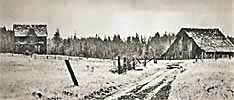|
British Newspapers
and the Oregon Treaty of 1846
March 22, 2003
Oregon Historical Quarterly
by Thomas C. McClintock
In 1846, THE UNITED STATES and Great
Britain finally settled their long-standing
dispute over the boundary between the U.S.
and British Canada in the Oregon Country, a
dispute that became known as the "Oregon
Question." The first official attempt
by the two nations to settle the dispute was
in 1818. Unsuccessful, they agreed to joint
occupation of the region for ten years.
Failing to reach a settlement again at the
end of that decade, they continued
joint occupation indefinitely with the
provision that if either nation wished to
terminate the arrangement it must give the
other a year's notice.
The two nations found it so difficult to
reach a settlement because the boundary each
proposed was so unacceptable to the other.
Great Britain maintained that it should hold
all of the region north of the Columbia
River from the point where it crossed the
forty-ninth parallel to the Pacific, thus
awarding Britain all of Puget Sound and
present-day western Washington. The U.S.
eventually would claim all lands south Of
54'40" Of north latitude--that is, the
southern boundary of Russian Alaska.
Ironically, both nations had favored the
forty-ninth parallel as a compromise, but
prior to 1846 one or the other party had
always rejected it.
In the 1840s, however, developments occurred
in both nations that finally made a
settlement possible. Probably most crucial
was Lord Aberdeen's return to the office of
the British foreign secretary. In addition,
both nations were under great pressure to
settle the dispute. In Great Britain, for
example, there was a growing fear of war
because of the demand by increasingly vocal
expansionists in the U.S. for "Fifty-four
Forty or Fight" and the bellicose tone of
President James Polk's inaugural address in
March 1845 and other pronouncements. In the
U.S., war with Mexico appeared to be
inevitable, and there was growing pressure
on the government to reach a peaceful
settlement on the Oregon Question. As a
result of these and other developments,
President Polk forwarded the forty-ninth
parallel compromise proposed by Aberdeen to
the U.S. Senate as a treaty, though without
his endorsement. The Senate ratified it
without change on June 18, 1846.
Was the compromise also favorably received
in Great Britain, at least as revealed by
the reactions of magazines and
newspapers? According to Richard S.
Cramer, although British magazines
“staunchly upheld British rights to Oregon
almost to the end," they then accepted "with
scarcely a murmur" the compromise Aberdeen
had proposed. Frederick Merk, the American
historian who has provided the most detailed
account of the thirty-year effort to settle
this territorial dispute, concluded that the
"whole British press" greeted the news of
the Senate's ratification of Aberdeen’s
proposed treaty with "a sigh of relief" and
"universal satisfaction."
Merk may have been correct, but the evidence
he provided is hardly persuasive. Not only
did he cite only one British newspaper, the
London Times, but, as Merk himself
acknowledged elsewhere, no other British
newspaper would have been expected to be as
favorable to the Oregon Treaty as the
Times. The young editor of the Times,
John T. Delane, had been carefully
cultivated by Lord Aberdeen for just such a
purpose. According to Arthur Dasent,
in his biography of Delane. Shortly after he
became editor, Delane was admitted to the
confidence of a Minister for whom he
conceived an enduring admiration and
respect. This was Lord Aberdeen .... The
communications which passed between Lord
Aberdeen and the editor of the Times were
verbal, and hardly a day passed without
their meeting. Aberdeen's communications to
Delane were inside information concerning
planned diplomatic and other initiatives by
the Peel government, information that would
have been eagerly sought by any member of
the press.
The foreign secretary's efforts had been
well rewarded. On January 3, 1846, Delane
published a long editorial on the Oregon
territorial dispute in the Times. After a
rather detailed discussion of the reasons
why "joint occupation of the [sic] Oregon by
British and American settlers is no longer
judged expedient" and, thus, why "partition
is recommended and desired," Delane informed
his readers:
We think, then, that every purpose both of
honour and interest would be answered, if
the British Minister [Lord Aberdeen], on
whom now devolves the duty of making fresh
proposals to the Government of the United
States, were to renew on his part the offer
made to England [in 1826] by Mr.Gallatin [at
that time a special envoy to London] in the
presidency and under the direction of Mr.
Adams. That proposal was to take the 49th
degree of north latitude as far as the sea
[Puget Sound] as the boundary line,
reserving to Great Britain Vancouver’s
Island, the harbour of St. Juan de Fuca [?],
and the free navigation of the Columbia.
It was no coincidence that the compromise
terms proposed by Lord Aberdeen and
presented by Richard Pakenham, British
minister to the United States, to U.S.
Secretary of State James Buchanan the
following June were virtually the same as
those suggested by Delane. (Aberdeen's
terms would be forwarded to the U.S. Senate,
where the treaty was ratified on June 18,
1846, without change.
Adding to the value of Delane's editorial
for Aberdeen in his efforts to prepare the
nation for a compromise settlement of the
Oregon…
The full text of this article is found here
|






